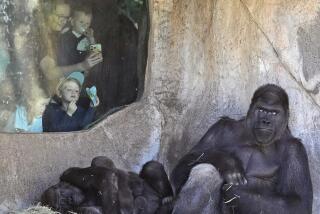Butterfly love at Smithsonian’s National Museum of Natural History
A visit to the Smithsonian’s National Museum of Natural History was the last place I expected to be picked up by a stranger.
It was a brief relationship. Ultimately, a fly-by-night kind of thing, although it happened at 11 a.m.
The scene of the tryst was the ongoing “Butterflies and Plants: Partners in Evolution” exhibition set in the new $3-million Butterfly Pavilion on the museum’s second floor. On display is a butterfly population that at any one time runs into the hundreds, with a focus on tropical climate insects from Central and South America, Asia and Africa.
Step inside and prepare to be dazzled. The butterflies seem transported from a surrealist’s vision of paradise, one where exotic colors and patterns flit about, hang from sticks, and cling to all manner of surfaces.
One of which turned out to be my head.
I had only been inside a few minutes when other visitors started peering and pointing at me. I had unknowingly attracted a Charaxes acuminatus, also known as a Mountain Pearl Charaxes.
I slowly removed my baseball cap for a close-up look. The butterfly was flattened to the surface, keeping very still, its wings closed, tangerine-orange coloring slightly mottled by dark striations. A tiny antenna fluttered slightly, seemingly waving at me. I was instantly charmed.
A nearby guide explained that when it chose to fly away, this butterfly would reveal a delicate white shading on the inner side of its wings. Based on the depth of its coloring and size, the guide estimated it had emerged from its chrysalis -- a hatchery is on display within the habitat -- in the last couple of weeks and would probably live four to six weeks more.
It turned out my 1-inch hitchhiker had traveled farther than I to strike up our acquaintance.
Native to Eastern Africa, indigenous to the area’s regional highlands, the larvae from which this butterfly came was grown at a Costa Rican butterfly farm and exported to the exhibit. (The U.S. government has a strict immigration policy on foreign insects. Butterfly exhibitions are banned from letting larvae and eggs from nonnative species stray from sealed environments.)
As the two of us promenaded through the pavilion, my butterfly was sticking with me, quite literally. I nicknamed it “Char” and began to read up on its entomology.
I learned that butterflies have been around for about 48 million years. They are part of the same order of insects as moths, their comparatively drab cousins, which have been on the planet 170 million years.
Butterflies emerged when plants first began to flower. This symbiotic relationship is the focal point of the D.C. exhibition -- a microcosm of the Earth, which has about 350,000 species of flowering plants and up to 150,000 kinds of moths and butterflies.
It’s a safe bet that these colorful insects have been on mankind’s radar from its start.
One of the earliest known artworks made by humans, the Chauvet cave paintings in southern France dating back 30,000 to 32,000 years, include two otherwise unidentifiable drawings that are described as having a “butterfly shape.”
Skipping ahead to the late 1600s, Basho, the acknowledged preeminent practitioner of haiku in Japan, wrote dozens of verses about butterflies, including:
“April air stirs in
willow leaves . . . .
a butterfly
floats and balances”
On this April day, my interest in floating and balancing led me to the pavilion, which opened in February. It’s a squat, milky-white enclosure with 13-foot-high ceilings and 1,200 square feet of space. By early December, more than 240,000 had visited the habitat, at a rate of 35 visitors admitted per half hour.
I was certain I was special and that it was my magnetic personality that lured Char. But in a subsequent interview, Nate Erwin, the exhibition manager, offered an ego-deflating counter-theory: salt.
“Butterflies like to roost,” he said. “And the accumulation of sweat [on your cap] might have attracted it.”
Personal hygiene traits aside, it was certainly plausible. Kept at 80 degrees and 80% humidity, the enclosure was like taking steam at a green-centric spa, with puffs of moist air periodically whooshing through creases in the white marble walls. (Advice if you go: An effective antiperspirant is a good lifestyle choice.)
Meanwhile, a swarm of preschoolers touring the facility shrieked when Char was pointed out to them, some delighted, some alarmed. One wide-eyed girl turned to a friend and said, “The crazy man has it on him!”
After about 25 minutes the crazy man began to wonder how he would get it off him. Summarily giving Char the brush-off was more than something Dear Abby would have frowned upon . . . it seemed potentially hazardous to my companion.
But as I prepared to leave, one of the pavilion’s volunteers solved the problem by nudging Char off my cap with a small stick. Next, a magical moment: the Charaxes acuminatus’ white tones on its inner wings winked goodbye as it gently flapped away.
“In the dusk, in the jungle, it’d be like a ghostly flashlight blinking on and off,” said the admiring guide, clearly one of Basho’s disciples.
I felt good about the moment, the encounter and the place. Outside I recognized a man I’d seen in the habitat. “Hey, your butterfly?” he said. “Now it’s riding around on a kid’s shoulder.”
Some relationships just weren’t made to last.
travel@latimes.com
More to Read
Sign up for The Wild
We’ll help you find the best places to hike, bike and run, as well as the perfect silent spots for meditation and yoga.
You may occasionally receive promotional content from the Los Angeles Times.






